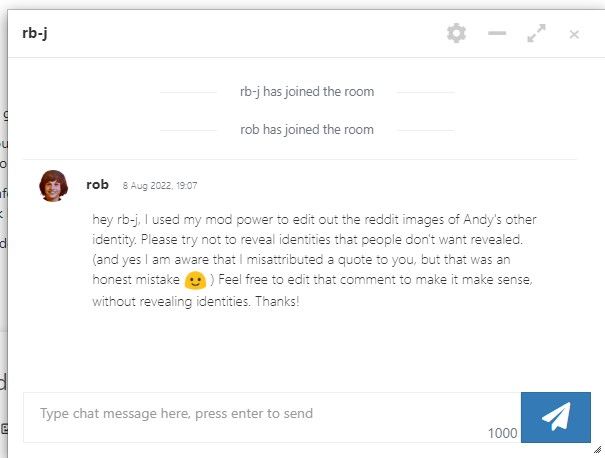@sarawolk said in My proposal for this forum:
We recruit some new volunteers to our Forum Council, Tech Committee, and Moderation Committee.
From where? The forum has been nearly a ghost town for most of its existence. But if a team of volunteers want to step up, that sounds like a plan and it doesn't sound like you need what I've offered. I will admit it seems a bit like magical thinking to me, but maybe you know something I don't.
I suggest you assemble this team of volunteers first, let them convince you that they are actually going to stick around and do the work, then make decisions. To me, it doesn't make sense to make decisions assuming a bunch of people are going to be ready to take on responsibilities, especially if those people haven't been participating in the forum already. I just don't see it happening.
When talking to Jack, he seemed to be convinced there was tech team ready to jump in. So maybe I'm wrong. I just have seen no signs of this.
We keep the forum constructive and drama free.
Offering to step up and run this democratically, per the original vision, doesn't sound like drama, and I would consider it constructive. I'm not attacking you or anyone else. I'm just saying the forum wasn't gaining traction, for very predictable reasons. Meanwhile the only person who has taken on day-to-day responsibility for the forum, Jack, says he's not willing to do that anymore. I have offered to spend a lot of my time, time that most people on the council don't seem to have, to both fill in the role Jack had played, while otherwise making positive things happen.
Also regarding drama: I've gone out of my way to try to suppress drama on the forum, only once using my admin powers (in a case of doxxing, I edited a post and diplomatically DM'd its author [1]), but often stepping in [2], sometimes in the awkward situation of, well, our tech admin posting stuff that many found offensive, off-topic and divisive. I don't know if anyone else ever has, other than a couple people weighing in, such as @spelunker did when he first arrived and was greeted by some toxic content, or as @Andy-Dienes did in that same situation. (I believe we've lost Andy, one of our best contributors --- I don't want to speak for him but I believe the "tone" of the forum was a significant thing that drove him away, and I'm pretty sure it wasn't because of a discussion of the future of the forum, since he also wished for some significant changes [3]).
Regardless, I am not trying to rehash events of two years ago, and am not attacking anyone. I don't see how this is escalating anything. I do feel that general issues about the forum's future should be resolvable in public at the forum. I understand taking things to private discussion for very specific cases, but for discussing how decisions are made at the forum and such..... why the need for secrecy? If you are worried about someone coming to the forum and being put off by my post...well, sorry, but I don't get it. If they are going to be put off by anything, it is that there is little activity, and whatever activity there is is not easy to find without several clicks, and if they do that, sometimes it is toxic and off topic. Not that we are talking about options to make the forum better.
I am honestly confused as to Jack's ongoing role. I understood he was wanting to back away due to frustration over a non-responsive council. If this wasn't the case, I would never have offered to step up.
That said, I think we need a lot more than what Jack has been doing, as I have outlined above. Basically, someone who is likely to be here on a daily basis, managing the social side, adding features and organizing the site and content etc. I don't see why a forum would be expected to succeed in the absence of this.
In any case, my offer stands for the time being but unless I hear strongly enough that people want this, I'm mostly assuming that the few left at the forum aren't interested.
-
(the doxxing has been removed but this is one conversation where moderation was otherwise needed) https://www.votingtheory.org/forum/topic/256/new-method-i-think-hare-squared/12
-
https://www.votingtheory.org/forum/topic/301/deutschland/14
https://www.votingtheory.org/forum/topic/303/the-metadiscussion
Note that if Jack wasn't the admin of the board, and we had anyone else who was actively moderating, a better way to handle it is for a moderator to delete the post, and DM Jack to diplomatically explain why without making a big public deal.
-
Here is where Andy suggested improvements , we all agreed, and nothing happened. If I had the role I propose, I would have put it to an open vote (on the forum), notified the council, and unless there were objections within a week or two, made the changes:
https://www.votingtheory.org/forum/topic/227/way-too-many-categories
I would have, separately, proposed and held a vote on changing the front page to be the "recent activity page", with a banner for links to other things at the site such as the CES forum archive.
 )
)